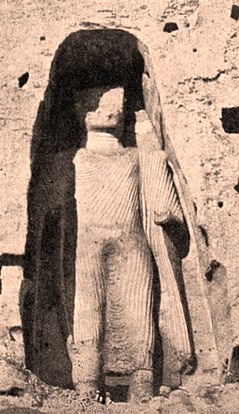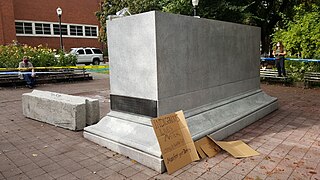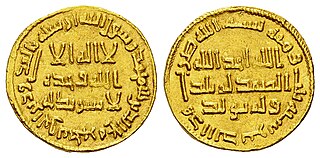 W
WIconoclasm is the social belief in the importance of the destruction of icons and other images or monuments, most frequently for religious or political reasons. People who engage in or support iconoclasm are called iconoclasts, a term that has come to be figuratively applied to any individual who challenges "cherished beliefs or venerated institutions on the grounds that they are erroneous or pernicious."
 W
WAniconism is the avoidance of images of sentient beings in some forms of Islamic art. Islamic aniconism stems in part from the prohibition of idolatry and in part from the belief that creation of living forms is God's prerogative. Although the Quran does not explicitly prohibit visual representation of any living being, it uses the word musawwir as an epithet of God. The corpus of hadith contains more explicit prohibitions of images of living beings, challenging painters to "breathe life" into their images and threatening them with punishment on the Day of Judgment. Muslims have interpreted these prohibitions in different ways in different times and places. Religious Islamic art has been typically characterized by the absence of figures and extensive use of calligraphic, geometric and abstract floral patterns.
 W
WBans on communist symbols were introduced or suggested in a number of countries as part of their policies of decommunization.
 W
WBeeldenstorm in Dutch, and Bildersturm in German are terms used for outbreaks of destruction of religious images that occurred in Europe in the 16th century, known in English as the Great Iconoclasm or Iconoclastic Fury. During these spates of iconoclasm, Catholic art and many forms of church fittings and decoration were destroyed in unofficial or mob actions by Calvinist Protestant crowds as part of the Protestant Reformation. Most of the destruction was of art in churches and public places.
 W
WA bonfire of the vanities is a burning of objects condemned by religious authorities as occasions of sin. The phrase usually refers to the bonfire of 7 February 1497, when supporters of Dominican friar Girolamo Savonarola collected and burned thousands of objects such as cosmetics, art, and books in Florence, Italy on the Shrove Tuesday festival.
 W
WThe Buddhas of Bamiyan were two 6th-century monumental statues of Vairocana Buddha and Gautama Buddha carved into the side of a cliff in the Bamyan valley of central Afghanistan, 130 kilometres (81 mi) northwest of Kabul at an elevation of 2,500 metres (8,200 ft). Carbon dating of the structural components of the Buddhas has determined that the smaller 38 m (125 ft) "Eastern Buddha" was built around 570 AD, and the larger 55 m (180 ft) "Western Buddha" was built around 618 AD, which would date both to the time when the Hephthalites ruled the region.
 W
WDonar's Oak was a sacred tree of the Germanic pagans located in an unclear location around what is now the region of Hesse, Germany. According to the 8th century Vita Bonifatii auctore Willibaldi, the Anglo-Saxon missionary Saint Boniface and his retinue cut down the tree earlier the same century. Wood from the oak was then reportedly used to build a church at the site dedicated to Saint Peter. Sacred trees and sacred groves were widely venerated by the Germanic peoples.
 W
WDuring the 2003 invasion of Iraq, a large statue of Saddam Hussein in Baghdad's Firdos Square was destroyed by Iraqi civilians and US soldiers. The event occurred on April 9, 2003. US government officials and media organizations, citing footage of jubilant Iraqis jumping on and sledgehammering the statue, claimed the event symbolized a victory for the United States, although this narrative was subsequently undermined by the growth of Iraqi insurgency. A retrospective analysis by ProPublica and The New Yorker concluded that the media had exaggerated both the size and enthusiasm of the crowd, had influenced the crowd's behavior, and subsequently had turned the event into "a visual echo chamber" that promoted an unrealistically positive account of the invasion at the expense of more important news stories.
 W
WThe Indigenous Peoples Day of Rage, often abbreviated as the Day of Rage, was a protest held in Portland, Oregon on October 11, 2020. The demonstration was declared a riot by the Portland Police Bureau and saw the toppling of two statues in the South Park Blocks as well as vandalism to the Oregon Historical Society and other local businesses.
 W
WDuring the civil unrest that followed the murder of George Floyd in May 2020, a number of monuments and memorials associated with racial injustice were vandalized, destroyed or removed, or commitments to remove them were announced. This occurred mainly in the United States, but also in several other countries. Some of the monuments in question had been the subject of lengthy, years-long efforts to remove them, sometimes involving legislation and/or court proceedings. In some cases the removal was legal and official; in others, most notably in Alabama and North Carolina, laws prohibiting the removal of monuments were deliberately broken.
 W
WPope Paschal I was the bishop of Rome and ruler of the Papal States from 25 January 817 to his death in 824.
 W
WThe use of flags from the German Third Reich (1933–1945) is currently subject to legal restrictions in a number of countries.
 W
WThe Protestant Reformation during the 16th century in Europe almost entirely rejected the existing tradition of Catholic art, and very often destroyed as much of it as it could reach. A new artistic tradition developed, producing far smaller quantities of art that followed Protestant agendas and diverged drastically from the southern European tradition and the humanist art produced during the High Renaissance. The Lutheran churches, as they developed, accepted a limited role for larger works of art in churches, and also encouraged prints and book illustrations. Calvinists remained steadfastly opposed to art in churches, and suspicious of small printed images of religious subjects, though generally fully accepting secular images in their homes.
 W
WA number of statues and memorials have been the subject of protests and petitions during the George Floyd protests in the United Kingdom in 2020.
 W
WYazid ibn Abd al-Malik, also referred to as Yazid II, was the ninth Umayyad caliph, ruling from 9 February 720 until his death in 724.